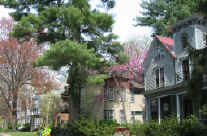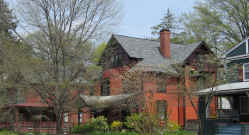|
We
Are 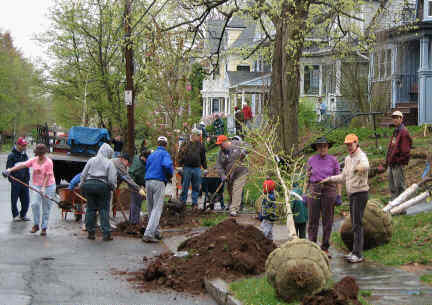
We
are the neighbors who live on Kenyon Street's first block.
We share a love for these beautiful Victorian homes and prefer living in the city.
We place a high value on appreciating our differences,
and discovering our sameness.
Some of us are new to city living, others have lived here
for decades.
We love to tell our story and share information.
To learn more about the people who live here,
click here
for links to some of our interests. 
--------------
 -------------- --------------
About
the Block: 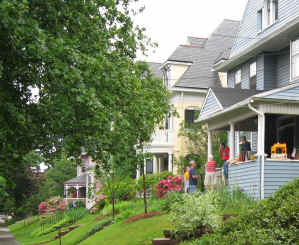
Kenyon Street
Kenyon
is only three blocks long, but it seems nearly every Hartford
area native had a relative who lived on Kenyon at one time over its nearly 140
years.
The houses are eclectic Victorian. They attract eclectic
owners, too.
Our block - the first block, is charming and vigorous at the same
time.
Close
enough to Farmington Avenue to walk when we want
something.
We're right between the Seminary-Law
School-Historical
Society-U
Hartford complexes, which are good for the mind, and
Elizabeth Park which
is good for the soul.
It's easy to get anywhere from here - and easy to get exposure to ideas and activities.
See
our central location.
In
the past year it has been easy to:
-
take a business course at
U of H's
annex,
-
attend an author's lecture at the Harriet Beecher Stowe
house,
-
enjoy Wednesday eves in winter, hearing from gardening experts
at Elizabeth Park,
-
take an internet marketing course at the library, etc, etc.
Others commuted a great distance to fit these into their
schedules, or just couldn't find the time, or more likely never knew
about them.
Living here, you hear more about what's going on, and then it's really a matter of swinging by. In a age
when most are isolated from their neighbors and pressed for time,
we have the gift of being in the center of everything, including a
community.
Because
we work at it, we have the best parts of an old-fashioned
neighborhood. To see our lovely homes, visit House
Map . To see the growth of homes on the block from 1869
to 1909, go to Historical Hartford
Maps. You can download these. 
--------------
 -------------- --------------
About 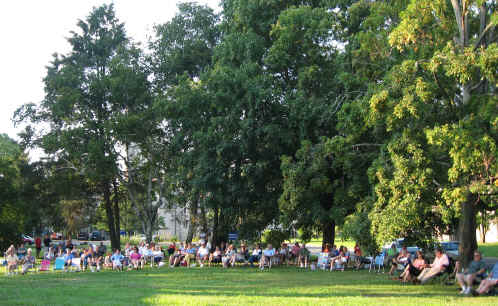
the Neighborhood:
The West End
Imagine it’s
1869-
It has been only four years since the Civil War.
Mark Twain won’t build his magnificent home on Farmington Ave.
for another 4 years. There is no neighborhood in the West
End. It's all farmland west of the Park River, divided only
by the major routes west and north: Farmington, Asylum, Albany and
Bloomfield avenues. Sisson Ave. and Prospect St. exist,
too. Only 29 families live along these roads in the
neighborhood.
Picture yourself standing at Farmington Ave. and the Park
River. The horse-drawn trolley, one of the first in the
nation, only runs out Asylum Ave. as far as Woodland Street.
You had to walk the rest of the way through the mud. You are
standing on a covered wooden bridge over the Park River. As
you look toward Prospect there are only 4 homes on the north side
of the street and another five on the south. All of them use
well water, despite the fact that the water supply for the whole
city runs beneath Farmington Ave. But this year, Farmington
Ave. will become an official city street, beginning to provide
water and sewer service along the Avenue.
Next year the first home will be built north of Farmington Ave.
– Kenyon's farmhouse up a path from developer Eugene Kenyon's estate
(at 96 Kenyon).
Another will be built across the street a few years
later. In 1871, the City replaces the covered wooden
bridge over the Park River with a stone bridge, costing
$28,000. Within a year, there is horse trolley service out
Farmington Ave. Three Second
Empire style homes go up on Sherman St. in 1877.
However, the economic downturns of the mid-1870's hit and Eugene
Kenyon goes broke. There is no
real development in the West End for another 10 years.
Fast
Forward: The
Early Decades in the West End
In 1899, the West End was the fashionable place to
build. Throughout the twenties and thirties sophisticates were on
the cutting edge (Chic Austin built his home
here). During World War II in the 1940s and into the 1950s, groups of young engineers from Pratt and Whitney, just
married, lived in the West End in rooming houses and got on the
company van to get to work. Young singles lived in Little
Hollywood and had a reputation for having fun. In the 1960s, families had grown up and out, leaving their older
parents in the family homestead. By the end of the 1960's,
some of these big houses
became crash pads for hippies.
The
1970's in the West End
In the 1970s, a handful of young couples - "urban
pioneers" bucking suburban sprawl bought neglected Victorians
at bargain prices and taught each other how to renovate "your
Victorian house in the city". The Old House Journal was
the renovator's bible. Activists at heart, they knew the
tools of organizing. Nearly everyone had a story of having
to insist that real estate agents show them property in the
city. Lenders and insurers were
accused of red-lining the city by refusing to make loans or insure
property. The
West End Civic Association (WECA) got a reputation for knowing the
nuances of the zoning code and turning out votes.
There were living room concerts, the West End
players, a craft group that specialized in jug wine, a monthly
neighborhood newspaper, The Westender, and great parties at the
drop of a hat. Everyone sent their preschoolers to Knight
Hall at the Seminary (pre-Law School) and Noah Webster
School. The neighborhood moms published Fun Spots -
a book of day
excursions to take the kids.
WENDCO incorporated as a non-profit organization
and began planning to save the Colonial Theater. Federal
funds were found to landscape and plant trees on Farmington
Avenue. "At Home in Hartford" buses brought
thousands of suburbanites on house tours all over the city.
First it was one house per block bought by a renovator, then two,
then three. Each paint job was celebrated, and each young
couple was added to the party list. Moms bonded through
playgroups, The West End book group held its first meeting.
And a neighbor's four year old became a plaintiff in Sheff v
O'Neil, Connecticut's landmark school desegregation case.
By the early 1980's the West End had
"turned around". Housing prices jumped - the West
End was hot. Suddenly, there were neighbors here you had
never met. This activism is the legacy of today's West End.
The
West End Now
Thirty-five years later the West End flourishes. The
West End Civic Association (WECA)
has been a bulwark of
action throughout the decades - advocating for the community, keeping us vital and strong.
The trees on the Avenue now tower over the street, the facade of the
Colonial Theater survives, reincarnated as Braza, a new
gathering spot. New
people are still discovering the neighborhood.
The Farmington Avenue Alliance has completed
plans for improving the streetscape for all of the Avenue, and the
Farmington Avenue Business District (FABD)
has championed a Hartford
Business Improvement District (BID)
along Farmington Avenue in Asylum Hill and all of downtown. There's a new
West End Community Center with services and programming for
kids and adults. The book group, the craft group and the playgroup
all are still going strong, even though the babies are all grown
up. We still party - the hardest ticket to get in town
is for WECA's annual progressive dinner and fundraiser: West End Dine Around....
The West End is the essence of a great city neighborhood because
we work at it.
West
End Demographics:
While the city as a whole has lost 11% of its population from 1990
to 2000, the west End has gained 3%. The West End has the
most even distribution of races in the city and in greater
Hartford: 36% white, 28% black, 21% Hispanic (2000 census).
With 18% of its population under age 18, the West End has an
average older population tahn other neighborhoods, the city and
greater Hartford. There are almost 4,300 households in the
neighborhood, almost half are 1 person. The average
household income is about $45,000 - the average for the city is
about $30,000 and the region about $61,000. About 25% are
below the poverty level, compared to 30% for the city and 7% for
the region. Almost 18% have a master's degree or higher,
compared to 5% for the city and 12% for the region. In the
West End 21% are foreign born, compared to 18% for the city and
10% for the region. (mostly from Jamaica, Vietnam, Brazil
and China).
About the block About
the city Hartford
Neighborhood Demographics 
--------------
 -------------- --------------
About
the City: 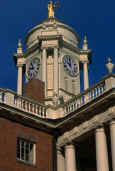
Hartford
Hartford at the
Beginning
The City of Hartford has been here since
1636
when the Rev. Hooker split from the Boston Colony Puritans because
they were too conservative. We compete with Windsor
and Wethersfield for the "who is oldest in Connecticut"
contest. Her institutions are a litany of
"firsts" in the nation. We
make the bald-faced claim that ours was the first constitution in
the world that lead to a democratic government.
This is at least the 7th life stage for Hartford, beginning as a Puritan center of merchant commerce: the highest navigable point
up the Connecticut River.
(It still is
- would Mark Twain have settled anywhere without an important
river?)
To see the growth of Hartford from 1637 to 1909, go to Historical
Hartford Maps. You can download many..
Hartford
in the 1700 and 1800's
Connecticut's charter from King George gave us the right
to vote for our own governor - the only colony that actually had the
authority to declare war on England. Washington slept here,
too. His portrait by Stuart still hangs in the Old State
House (1796), an architectural gem by Charles Bullfinch in the heart of downtown - and site for
much of the action of the Amistad slave case. The
"new" state
capitol on the top of Bushnell Park dates to 1878 when Trinity
College donated the site for the capitol and moved about a tenth
of a mile away. Get a sense of the times by visiting the Butler-McCook
Homestead.
Colt
Hartford became a major supplier of weapons and supplies
for the Revolution - not to mention the Civil War (Colt
firearms),
WWI (Gatling gun), WWII (Pratt engines). High Tech defense
still plays an important part of the Connecticut economy.
Colt's main man was an engineering genius who trained the next
generation of innovators in his early industrial incubator at the
Colt factory, soon to become a national park.
Stowe
and Twain
We had our progressive types back then, too. Uncle
Tom's Cabin turned more than a million readers into empathizers with the slave
cause. Lincoln credited Harriet Beecher Stowe
as being the "little lady" who caused the Civil War.
Her neighbor, Mark Twain was our own truth-telling international celebrity. Both Mark and Harriet left
us their legacies when they left their homes - now important
institutions in the city.
We had our own little gilded age as Hartford's early
industrialization paid off. Elizabeth Colt endowed the Wadsworth
Athaneum with her art collection. J.P. Morgan endowed a wing - local boy does good.
Hartford "magnates" established institutions
such as the Hartford Public
Library, the Bushnell and a
magnificent park
system.
Hartford
in the First Half of the 20th Century
Katherine Hepburn grew up in Hartford, riding her bike
to Elizabeth Park. Her mom
organized for "Votes for Women". The Athaneum was
center stage on the national arts scene, hosting the Ballet Russe,
famous for it's Black and White Ball and early collection of
impressionist greats, bought at bargain prices. Visit the Austin
House in the West End to get a glimpse of Chick
Austin, the man who pulled off cutting-edge innovation in
conservative Hartford. Gradually,
finance replaced manufacturing as the insurers stepped center
stage.
Hartford
in the 1950's and 1960's
The insurance industry had been around since 1810,
insuring the merchant shipping from the Port of Hartford, but it blossomed in the 1950s and
'60s as more Americans came to have more, and
wanted to hold on to it. The nation's file cabinet somehow left room for a
brilliant poet. Wallace Stevens was an insurance company exec who
wrote his poetry while walking to work each day from the west end
down Asylum Ave. to the office. You can walk his route.
The post-war race to the suburbs affected New England
cities more than the rest of the country. Hartford is only 2
miles wide by 7 miles long - geographically, it's tiny. Other
cities incorporated surrounding suburban areas - not possible in
this postage stamp-sized city. Something had to give.
Hartford
in the 1970's
In the 1970's, Hartford's famous rose garden in Elizabeth
Park became a symbol of
disinvestment. The city's poverty and strapped budget could no longer
maintain her extensive park system. So the city wrapped the
famous rose garden in a towering burlap "fence" as a way
of demonstrating that since no one but Hartford would help pay to
keep it up - outsiders would have to pay admission.
The
Friends of Elizabeth Park was born, and has been a wonderful
resource ever since. (Our block has adopted a rose
bed). The state has yet to solve the problem of taxing and
service equity, but, you know - Hartford wasn't built in a day....
Hartford
Today
All the richness of Hartford's history is here to
enjoy. Plus a host of newer institutions like Hartford
Stage, TheaterWorks,
Real Art
Ways, the Connecticut
Forum, Riverfront
Recapture, the Hartford Preservation Alliance and new
plans for exciting developments in Pope and Colt parks.
The legacy of activism here gets re-channeled as successes are
checked off the list.
Hartford's tiny 17 square miles contains a
concentration of all the institutions of any major city: the seat
of state government, 4 major hospitals, major colleges and
universities, some of the largest financial and tech corporations
in the US, major media, the crossroads of the state's
transportation system, a wealth of history, arts and entertainment
and about 120,000 residents - all packed into the small footprint
of this city - home to so much.
History of the
West End

--------------
 -------------- --------------
About 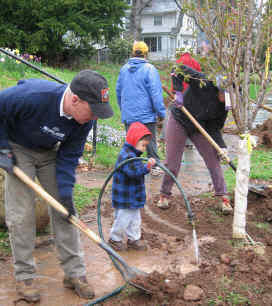
the Website
A
digital camera can be an addictive thing.
It was given as a
holiday gift and made its debut at the Kenyon Street tree planting
on April 22, 2006.
Despite the gray mist, the day was incredibly energizing - the
block was in bloom and over 30 neighbors wielded shovels, ready to
plant new street trees. It was as if someone had staged
a heartwarming event for a T.V. commercial. But this was for
real.
Then there were all these photos that documented this wonderful
bonding experience. How to share them?
With a penchant for building websites as a way of sharing all of
life's interests: (the bookgroup, the
foodgroup, the
jewelry and card
business), a website for Kenyon Street was the obvious choice.
-
The
Kenyon Street website started with one page - It tells the
story of the "Knox
Tree Planting" with pictures.
-
The
block's annual progressive dinner is a
"must". Why not put
the Kenyon Street "Event Calendar" up, too?
-
We polled everyone about what they liked and they told us, hence
"We Love".
-
The "House Map" was a natural, since
Doug's phone list is
laid out that way. Here your historic Victorian is your
pride and joy - why not share it?
-
Why not post it when houses
on Kenyon Street are up for sale? "For Sale
Signs" is a great way
for people in Greater Hartford to find out about Kenyon Street.
-
As
one who has lived in Hartford for several decades, "Links" was a chance to pass along valuable tidbits of
information along with the history of Hartford, the West End and
Kenyon Street, both practical and obscure.
-
When
the gardeners started to share their gardens every other
week, "Garden Walks"
became a resource documenting it all.
This
website is a love poem, really. 
--------------
 -------------- --------------
How
To Build 
a Neighborhood -
one block at a time
10 Steps
-
Garden
in the front yard, or hang out on the front porch and chat
with everyone who passes. Get out of your car and
walk. You will meet people.
-
Call
up a neighbor and have coffee, then dinner together.
-
Introduce
everyone to everyone.
-
Someone
has an idea to do something fun. Someone invites
everyone they know on the block, even if it's only three
people. When you get together, offer a tour of the house - we
all love to see each other's houses.
* It helps to have
a "social engineer", a cheerleader who loves to
entertain.
-
Someone
collects phone numbers and e-mails. Give everyone on the list
a copy.
* It helps
to have an organizer, someone who will collect the
information.
-
In
the winter, suggest a dessert party to set the social calendar
for the year -
whoever wants to host something suggests a date. Once a year,
once a quarter, once a month. It doesn't matter how
often, if it's
periodic and you give it a name, it will seem like an
institution even the first year.
Do up a calendar and get a copy to everyone. Then remind
people. Twice.
While e-mail is indispensable, a flyer delivered to the house
will turn more people out. A phone call even more, and a
personal written invitation (on paper with an envelope) will
mark the occasion as a special one.
* It helps
to have a communicator, someone who wants everyone to know.
-
Have
a progressive dinner where people sit at tables - it's a real chance to discover people
you haven't met. Everyone is an expert at
something. Now you have "experts" to ask.
-
Pull
the whole block in when you can - someone wanted to do a tag
sale - in the end 14 houses on the block
participated.
One of us was a gardener, turns out lots of us are gardeners -
now the interested folks "walk" the gardens twice a month, sharing
tips and plants.
-
When
an issue comes up that needs a solution, you already know
everyone and how to reach them. E-mail , e-mail,
e-mail! Organize, Call on your resources.
But start with the fun stuff first.
-
Offer
to help your neighbor. Once you know them, you'll
discover ways to help each other. Mutual support is what makes a
real community and strengthens it.
A
neighborhood is about people.
Here, the people think this place is special. We work to make
it special.
To learn more about some of the people who live here,
click here
for links to some of our interests.

-------------
 -------------- --------------
- Kenyon Street -
How
to Build

a Website
10 Steps
-
Decide
the purpose of the site and who your audience is. Never
lose sight of the point and who you're talking to.
-
Take
a free basic course at the library.
-
Buy
FrontPage or another website software tool. Not
mandatory - it's just a lot easier.
-
Locate
a free website host. This one's up on angelfire.com.
They have lots of help for newbies.
If you can afford $100 - $150 a year or so (every year), you
get your own domain name (website address), have the site on a more reliable
website host, won't have advertising forced on your site and
will have more tech support and capacity for larger files for
photos, etc..
-
Learn
the basics: Posting text, photos, files and how to do
hyperlinks.
-
Bring
a digital camera to block events. Go out on a beautiful
day and snap the good stuff.
-
Ask
what people would like to see on the site. Jot down the
main ideas and organize them into pages. Type them up,
add pictures and post the pages. Start small. It
will grow as you have time to add. Remember to keep people's privacy.
-
Test
the site, test the links. See how it works on different
computers.
-
Let everyone
know.
-
Keep
it lively - adding new things and bringing it up-to-date.
(Google Books and Google Images are both invaluable research
tools.)
Then remind everyone whenever new features are added.
* It helps
to be organized, dogged and have good color and graphic sense.

-------------
 -------------- --------------
Site Map

To see a Table of Contents for the Kenyon Street
website, click here.
You'll find an index of major features on this website at a glance.
--------------
 -------------- --------------
Contact
Us
We welcome all comments. If something is
incorrect or out of date, let us know.
If you have an
event or information you'd like to get out to Kenyon Street's first
block, e-mail us with enough advanced notice, and we'll get it out.
E-mail us at
C. West Designs: cwestdesigns@snet.net.

|
